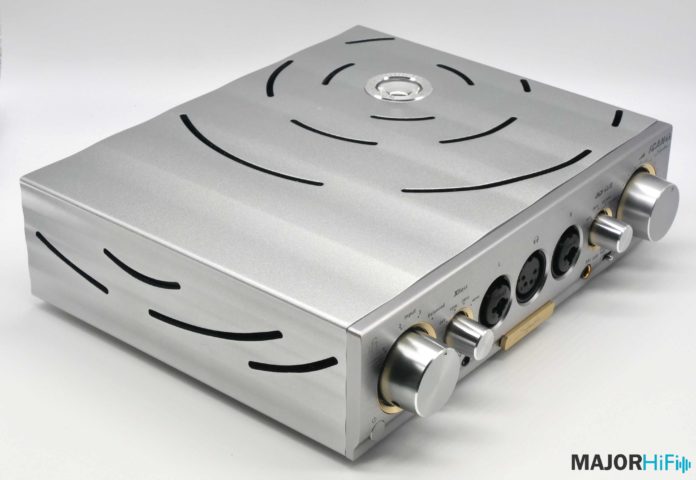A brand dominating the headphone amp market at the moment, iFi seems to constantly have new products rolling out, and I personally can’t get enough of it. Today we’ll be looking at one of their most high end amps, the brand new Pro iCAN Signature, the follow up to the Pro iCAN. Running for $2249, this is definitely a pricey purchase, but let’s see what this amp is all about before we pass any judgements.
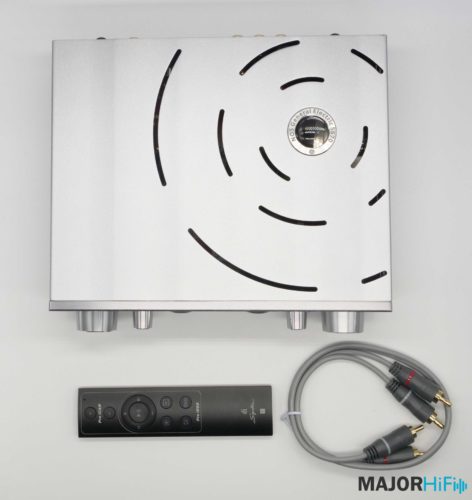
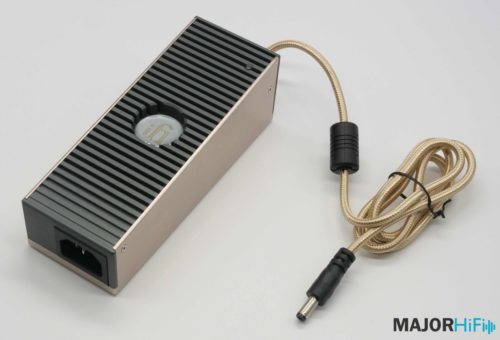
What’s in the Box
- iCAN Signature
- RCA Cable
- User Manual
- iPower Elite
- Infrared Remote Control
- General Accessory Instruction Card
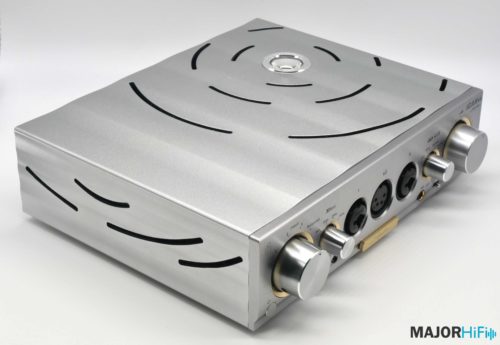
Look and Feel
Like all iFi amps I’ve used, the iCAN Signature is both sturdy and stylish. The volume knob is a nice size and protrudes a comfortable amount. It has some light resistance to it, which is good for preventing accidental volume adjustments. When Tube and Tube+ mode are enabled, the tube’s orange glow can be seen from the top of the unit, though it made need 45 seconds or so to heat up. The iCAN Signature uses a quad-damped isolation base mount to provide vibration dampening control, electromagnetic shielding, and help with resonance distribution and minimization. This amp is definitely built like a tank, but it still retains a sleek look and modern shine.
Ins and Outs
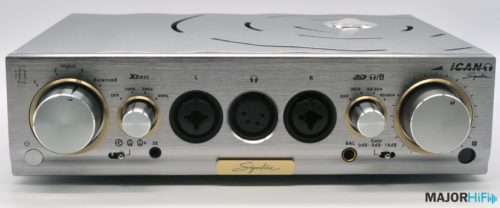
Front – Headphone Output Sockets:
- XLR 3 Pin x 2 (Balanced)
- 6.3mm x 2 (Balanced/Single ended)
- 3.5mm (Single ended)
- XLR 4 Pin (Balanced)
- 4.4mm (Balanced)
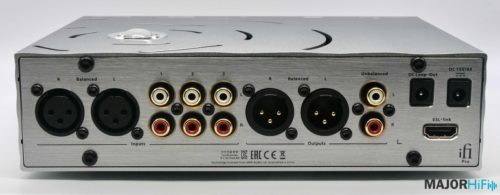
Back:
- XLR input (Balanced)
- RCAs x 3 input (Unbalanced)
- XLR output (Balanced)
- RCA output (Unbalanced)
- DC Loop-Out (for use with iCAN add-ons)
- iFi Pro iESL connector
- DC Power Supply Input (15V/4A)
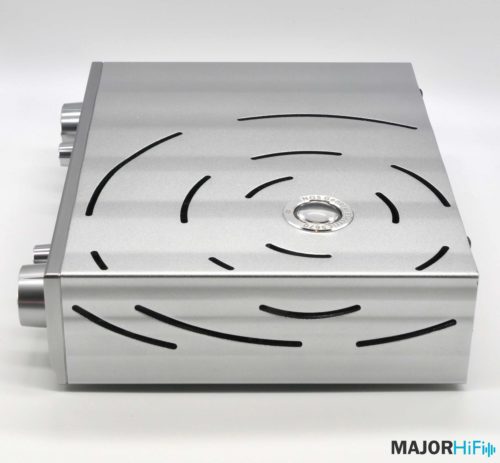
Design
the iCAN Signature is meant to be a “reference-class analogue headphone/stereo preamplifier.” It features a customizable bass boost (“XBass”) and sound expansion (“3D Holographic”). It also features different operational mode: Solid-State, Tube, and Tube +. Some internal features include:
- 6-Way motorized ALPS type volume control, with 4 tracks adjusting volume and two others for monitoring volume control operation.
- An audio-circuit developed with iFi’s ‘TubeState’ design.
- Full integration of the 3D Holographic function into the signal circuit, meaning there’s no use of DSP and the linked AD/DA conversion and no additional active elements.
- If disabled, the passive elements of the analogue matrix are removed from the circuit, ensuring that the signal remains unaffected.
What’s New about the Signature?
- Revised circuit design
- Upgraded power supply circuits
- Hand-selected and matched tubes in the output stage
- 4.4mm Pentaconn balanced headphone output
- New Remote Control
Sound Quality
I tested this amp with the Focal Clear MG, Dan Clark AEON 2 Open, Beyerdynamic DT1990 Pro, Hifiman Ananda, and Audeze LCD-2
Unsurprisingly, the iCAN Signature offers some wonderful vintage tube warmth to your headphones. Brightness is softened and given a more organic texture, while low end is de-mudded and tightened. Mixes tend to be more glued and melded with increased cohesion and clarity. The iCAN Signature does a great job of offering sonic differences you can appreciate and notice without implementing so much modulation and color that your headphones start to feel unfamiliar and repurposed.
Output
As expected, the iCAN Signature offers a considerable boost and should be able to drive any headphones you throw at, whatever their impedance. I found the 3.5mm output sometimes required a bit more volume pushing than the others did, as expected. I’d opt for the 4-pin if you can.
Operation Modes
• Solid State mode: This was unsurprisingly the most transparent, and does allow you to get a hair more out of the XBass mode at times it seems. This was my default mode at many times, as it had the most versatility.
• Tube Mode: Tube mode offered a crisper but warmed up high end, that was definitely better fitted for some headphones than others. It offered a similar warmth to the bottom end, though not quite the grip that Tube + had. I did enjoy its looser feel when I really wanted a low chest punch sensation to come through.
• Tube + Mode: I found the Tube + mode (not to be confused with Tube mode) to be my favorite. It added the most natural, warm, balanced feel to each headphone I tested out and offered a more smoothed out high end than one that was ultra crisp. Especially when used in tandem with the XBass, it made sure any added punch remained controlled and clean no matter what.
XBass
- 10Hz: This is the most subtle of the three modes, and will be hard to detect on some headphones that don’t reach that far down. When it is detectable, its effects are more physical than audible, allowing for more realism and cinema from music, but not generally an obvious increase in any recognizable timbre.
- 20Hz: While this mode is still subtle, it is more noticeable than the 10Hz setting, of course. I enjoyed the understated boost this offered, making a clear change but one that’s never overwhelming, and never sacrifices balance or cleanliness.
- 40Hz: I’ll be honest, this was my favorite setting simply because it was the most exciting and intense. This boost will definitely be a little overkill on some headphones and/or songs, but at large keeps things balanced enough. This option reminded me most of the default bass boost on other iFi amps like the Zen DAC and Zen DAC V2.
3D Holographic
This function seems more aimed at speakers than it does headphones. It’s meant to restore the recording to its original soundstage, which may have been spatially distorted during recording/mixing/mastering. It is also meant to allow the width of the soundstage to stretch beyond speaker placement, particularly narrow speaker placement. On the headphones I tested, this function seemed to reformat the soundstage more than it did expand it, often dropping out the middle a bit and lightening up the low end/mid range of the outer edges. On some headphones, like the AEON 2 Open, it in ways felt to be making the soundstage a tad bit more narrow.
Overall
The iCAN Signature is a successful upgrade that further refines, fine tunes, and cleans up the sound of the already impeccable original iCAN model. It offers its users the option to get increased fidelity while retaining transparency or to add some top-notch color and saturation to their system. The ability to personalize, with customizable features like XBass and 3D Holographic, make this amp a real jack of all trades and ready to serve a wide range of preferences and applications.
| Pros | Cons |
|
|
You can purchase the iFi Pro iCan Signature at Audio46.
Compare the ranking of various headphones, earbuds and in-ear monitors using our tools.
Discuss this, and much more, over on our forum.
---MAJORHIFI may receive commissions from retail offers.


